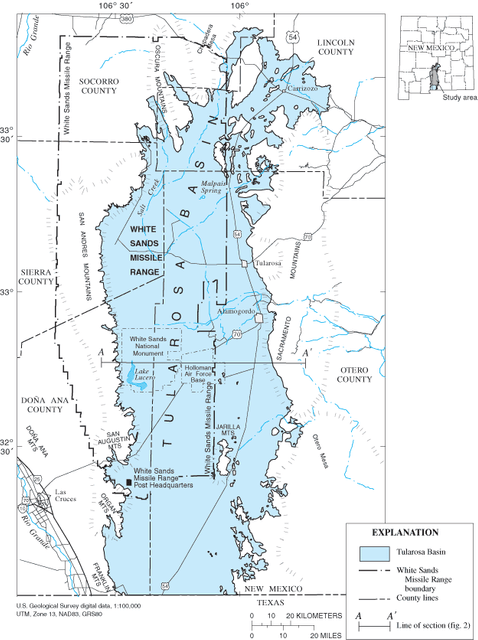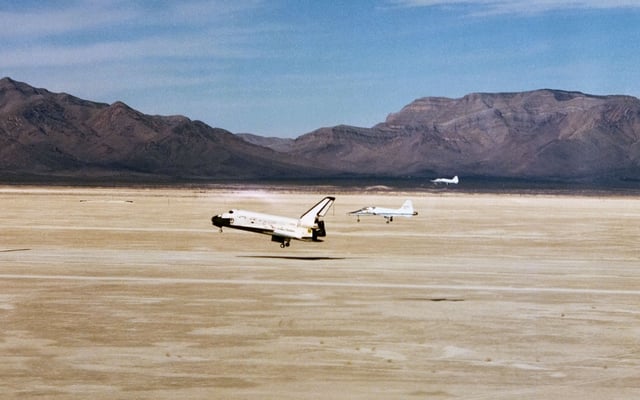White Sands Missile Range

White Sands Missile Range

| White Sands Missile Range (1960)[1]New Mexico Joint Guided Missile Test Range (1947)White Sands Proving Ground (1945) | |
|---|---|
| Part ofUnited States Army Test and Evaluation Command | |
| Coordinates | [3](Condron Army Airfieldnear the southernmost WSMR point) |
| Site information | |
| Controlled by | United States Army |
| Website | |
| Site history | |
| Built | 1948-07-09 cantonment completed[4]1957-02: Launch Complex 37 completed |
| Built by | Ordnance Corps[4] |
| Garrison information | |
| Currentcommander | COLDavid C. Trybula (2019–present)[5] |
| Pastcommanders | |
| Images | |
| Video | |

The site of the 1945 Trinity explosion became part of WSMR.
White Sands Missile Range (WSMR) is a United States Army military testing area of almost 3,200 sq mi (8,300 km2) in parts of five counties in southern New Mexico. The largest military installation in the United States, WSMR and the 600,000-acre (2,400 km2) McGregor Range Complex at Fort Bliss to the south (southeast Tularosa Basin and on Otero Mesa[7]) are contiguous areas for military testing.[8] On 9 July 1945, the White Sands Proving Ground was established for testing German and American long range rockets. Just seven days later, the first atomic bomb test, code named Trinity was exploded at Trinity Site, near the north boundary of the range.[9]
| White Sands Missile Range (1960)[1]New Mexico Joint Guided Missile Test Range (1947)White Sands Proving Ground (1945) | |
|---|---|
| Part ofUnited States Army Test and Evaluation Command | |
| Coordinates | [3](Condron Army Airfieldnear the southernmost WSMR point) |
| Site information | |
| Controlled by | United States Army |
| Website | |
| Site history | |
| Built | 1948-07-09 cantonment completed[4]1957-02: Launch Complex 37 completed |
| Built by | Ordnance Corps[4] |
| Garrison information | |
| Currentcommander | COLDavid C. Trybula (2019–present)[5] |
| Pastcommanders | |
| Images | |
| Video | |
National Historic Landmarks
Designated historic sites on WSMR land include:
Trinity Site: Selected in November 1944 for the Trinity nuclear test conducted on 16 July 1945[10] (National Historic Landmark district on 21 December 1965,[11][12] NRHP on 15 October 1966).[13]
White Sands V-2 Launching Site: A V-2 static test firing was 15 March 1946, and the first US V-2 launch was 16 April 1946 (landmark designation 3 October 1985).[14][15]
Current operations
The Launch Abort Flight Test Complex for the Pad Abort-1
White Sands Launch Complex 37, built for Nike Hercules tests
White Sands Launch Complex 38, built for Nike Zeus tests with Launch Control Building now used for Patriot missile firings
"WSMR Main Post", which includes several smaller areas such as the housing area, golf course, "Navy Area", and "Technical Area"[17] (a recreational shooting range just inside the "El Paso gate" on the south is outside of the Post Area.) WSMR Museum tours and exhibits, which include V-2 rocket returned in May 2004 after restoration. White Sands Hall of Fame, which inducts members such as the first range commander (1945 - 1947), Col. Harold Turner, in 1980.[18] 1972 DoD Centers for Countermeasures (CCM), which evaluate precision guided munitions and other devices in electronic counter- and counter-countermeasures environments.[19]
1963 NASA White Sands Test Facility's ground station for Tracking and Data Relay Satellites and the SDO ground station with 2 18 m (59 ft) antennas.
The North Oscura Peak facility of the AFRL Directed Energy Directorate
Chronology
1930: Robert Goddard began rocket testing in New Mexico.
1941-04-13: US World War II preparations established[10] the Army Air Base, Alamogordo:[20] 1942 Biggs Army Airfield construction began near El Paso (1947 Biggs AFB, 1973 Biggs AAF)--the region's nearby Deming AAF (14 Dec 1946), Ft Sumner AAF (6 Mar), and South Aux Fid #1 (4 Apr) transferred to "Army Div Engrs" in 1946.[21]
1940s: When the range was formed, ranchers' land was leased and, in the 1970s, taken permanently to expand the area available for testing.[22]
USAAF ranges
1941-12: Alamogordo Bombing and Gunnery Range established near the "West Texas Bombardier Triangle".
1941-12: Executive Order No. 9029[2] canceled grazing leases on the newly established Alamogordo Bombing and Gunnery Range.
1942-07: Goddard's rocket research group moved from Roswell, New Mexico, to Annapolis, Maryland.
1944-02: War Department and the Corps of Engineers' Ordnance Department teams looked for a US missile test site.[23]
1945-07-13: McDonald Ranch House, Manhattan Project location for the final assembly of the prototype Fat Man plutonium bomb.
1945-07-16: Trinity test of the plutonium bomb, the first nuclear weapon tested in the world.
White Sands Proving Ground
1945-02-20: The Secretary of War approved establishment of WSPG.[24] [23]
1945-04-01: The first Private F launch[25] was at WSPG. (Not Fort Bliss's Antiaircraft and Guided Missile Center, which was established 6 July 1946.)[26]
1945-06-25: WSPG construction began with drilling of water wells.[10]
1945-07: First of 300 railroad cars of German V-2 components began to arrive at Las Cruces, New Mexico.[24]
1945-09: The blockhouse at Army Launch Area 1 (later Launch Complex 33) was completed.[10]
1945-09-16: First WAC Corporal test firing.[24]
1945-11: GE contractors began to identify, sort, and reassemble V-2 components in Building 1538 (Assembly Building 1). [58]
1946: 35 of the Operation Paperclip scientists from Germany were working at WSPG.[27]
1946-05-26: The 4th U.S. V-2 launch was tracked by "two AN/MPQ-2 stations".[28]
1946 summer: New WSPG quarters were completed and the Medical Detachment and 3 batteries moved from Ft Bliss.[29]
1946-09: First static firing of a Nike missile was at WSPG.[30]
New Mexico Joint Guided Missile Test Range
1947 (late):[31] A merging of military areas (e.g., former USAAF bombing range and the smaller WSPG) established the "New Mexico Joint Guided Missile Test Range".[21]
1947-11-14: The USAF's Alamogordo Guided Missile Test Base (AGMTB) on the range had its first GAPA missile launch (39th for GAPA and first with a ramjet).[33]
1948-05 to 1949-4: First six flight attempts for the Project Bumper two-stage V-2 SRBM/WAC Corporal two-stage research vehicles as the world's first "high-speed" multistage rockets to be launched.
1948-07: USAF Project MX–774 commenced with the first RTV-A-2 Hiroc launch (from Launch Complex 33)[10]
1949-03: Holloman's 2754th Air Force Base unit gained "control of [the WSPG] support airfield, Condron Field…from Biggs Army Air Field at Fort Bliss."[10]
1949: German scientists transferred from New Mexico to Alabama (Dr. Ernst Steinhoff transferred from WSPG to Holloman's Air Development Center.) [59]
1949-07: The range's Four Bits Peak Instrumentation Annex was assigned to the AFB (disposed on 30 September 1960).[21]
1951-07: The AGMTB became a sub-base of Florida's Air Force Missile Test Center until 31 August 1952.[35]
1951-08-22: Broomstick Scientists in a unit of the 9393 Technical Service Unit conducted their first launch: the "TF-1" V-2 rocket.[36]*Vengeance%20Weapon%202%3A%20T]][37](*Broomstick Sweepings uary 1952 general order transferred "1st Ord. GMS Bn." soldiers to Detachment No. 1, Station Complement.)[38]
1952-05: An additional 40 mi × 117 mi (64 km × 188 km) was set aside for the "Alamogordo bombing range, White Sands proving ground, and the Fort Bliss antiaircraft range".[39]
1952 (mid): The joint range of more than 200,000 acres (81,000 ha) was 2nd in area to the Eglin AFB range (the Edwards AFB range was 3rd.)[21]
1952-11: The range's Red Butte Instrumentation Annex was assigned to Holloman AFB (disposed on 22 November 1963).[21]
1953-06: USS Desert Ship (LLS-1) (Launch Complex 35) was built to test the Navy RIM-8 Talos missile.[10]
1957-02: The 9393rd Technical Unit, Ordnance, became the U.S.
Army Garrison.[40]
1957-03-13: Nike Hercules satisfactory launch from LC37.[41]
White Sands Missile Range

1982 Space Shuttle Columbia landing at Northrop Strip
1958-05-01: The test range was designated "White Sands Missile Range".[10]
1958-09-02: The Gold Hill Instrumentation Annex was assigned to Holloman AFB (disposed on 30 September 1960).[21]
1958-10: Zeus Acquisition Radar site construction at the planned Launch Complex 38 began[42] near an airstrip.[43]
c. 1959: The long-range GE AN/FPS-17 Fixed Ground Radar at the Laredo Test Site tracked its first WSMR rocket.
1959: Shavetail rocket tested.
1959: An Iconorama large screen display as used for Pentagon C2 was installed at WSMR.[44]
1963: President John F. Kennedy visited for the MEWS (Missile Exercise White Sands).[45]
1962-03: Annual Service Practice was being conducted for Redstone missile crews.[46]
1963-03: Site preparation began for the Multi-function Array Radar.[47]
1963: Apollo program Launch Escape System tests with the Little Joe II began at White Sands Launch Complex 36 (ended 1966).[48]
1963-11: The Loma (assigned December 1952), Rose Park (5 February 1950), & Twin Buttes (December 1949) instrumentation annexes transferred from Holloman AFB to the Army.[21]
1964-07-08: The first "successful Athena/ABRES test missile [was] fired from Utah into WSMR".[49]
1965-11: first Sprint missile launch [2] [60]
1967: Operation Understanding civic leaders observed their local Nike crews perform Short Notice Annual Practice launches.[50]
1967-10-21: Public Law 90-110 authorized $4,781,000 for WSMR construction.[51]
1972: WSMR had 3 RCA AN/FPS-16 Instrumentation Radars[52]
1983 thru 30 September 1993 - WSMR hosted the Simtel collection, the largest collection of free software and freeware available to the public on the ARPANET and Internet. It began as a copy of an MIT collection of CP/M software, and expanded to collect free software for other operating systems as well.[53][54]
1991 (late): Convair QF-106 Delta Dart drones based at Holloman AFB began operating as Full-Scale Aerial Targets over WSMR.
1993-08-18: The first McDonnell Douglas DC-X flight was from the White Sands Space Harbor
2004: AIAA named the WSPG a Historic Aerospace Site.[55]
2007-11-14: Launch Complex 32 groundbreaking for the Orion Abort Test Booster.[56][57]
2011: A point in the Post Area was designated "White Sands Missile Range" in the USGS's Geographic Names Information System.[3]
See also
McDonald Ranch House, location of the final assembly of the world's first nuclear weapon
Kapustin Yar, the Soviet analog of WSMR
Peenemunde Army Research Center, WWII German rocket center

